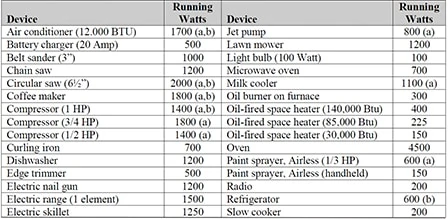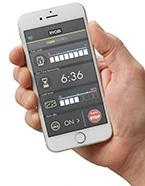The rise of invertor generators brings several advantages to the DIY market for portable power supplies. Inverter generators utilize a different type of alternator than standard generators to generate very clean AC power. The inverter technology reduces the generator’s size and weight, but more importantly, the engine can run at varying speeds, significantly reducing the noise levels and fuel consumption. These units also offer cleaner power for sensitive electronics.
How it Works

Conventional generators consist of heavy copper coils that generate a raw form of electricity. The engine must maintain a constant speed to produce AC power, regardless of the load needed, and this full-power operation consumes a lot of fuel and produces considerable noise. The electricity produced by a standard generator also isn’t as clean as utility power, so they’re not recommended to power sensitive electronics like laptops and cell phones.
Inverter generators, however, utilize a different type of alternator to generate clean AC power made possible by advanced electronic circuitry and high-tech magnets. These units generally have 3-phase generators that output AC current like traditional generators, but that current is then converted to DC, and then “inverted” back to clean AC power that maintains a single phase, pure sine wave at the required voltage and frequency.
The engine can operate at varying speeds, which reduces noise and fuel consumption compared to standard generators. Small inverter generators are designed to power multiple small appliances simultaneously, whereas larger inverter generators produce enough power to start the air conditioner of an RV while simultaneously running a microwave. Some of the newest models offer enough capacity to serve as a home backup generator. You can also pair two inverter generators in tandem to double your power while still benefiting from the clean, quiet power of an inverter generator.
This state-of-the-art technology was very expensive several years ago, but prices have dropped significantly on small recreational generators, making them popular with DIY’ers, RV enthusiasts and tailgaters alike. They’re great for running tools in remote locations, powering outdoor parties, tail-gating, camping trips, and even some emergency power during a blackout.
Sizes
Compact Inverter Generators. These small units produce 800 to 1,000 watts of power, which is just enough electricity to power one or two appliances simultaneously. For example, it could power a coffee pot alone (1,000 watts) or a toaster (700 watts) and crockpot (230 watts) simultaneously, because the latter two items would total only 930 watts.
Small Inverter Generators. To run more appliances simultaneously, upgrade to a smaller unit that generates 1,600-2,000 watts of electricity.

electric motors, such as light bulbs, radios and televisions, have the same running and starting wattage. However, devices with electric motors, such as refrigerators, compressors and hand tools will have a starting wattage significantly higher than the running wattage.
Medium Inverter Generators. Sometimes, “roughing it” isn’t all it’s cracked up to be, and we want to enjoy the outdoors along with the comforts of home. This larger size inverter provides the power output to keep the television on when you run an electric fan.
Larger inverter generators are ideal for travel trailers and pop-up campers.
Pairing Two Inverter Generators
Combining two inverter generators offers the ability to double power output while still maintaining clean, quiet power. If you don’t want to step up to a larger generator to get the power you need, you can invest in another inverter generator and connect them together with a set of cables for twice the power. This also keeps your power supplies nice and portable, rather than having a single large, heavy generator that’s difficult for one person to move.

Decision Time
So, which is right for you, a conventional generator or an inverter generator? Conventional generators are available in nearly any size you need, from 500 to 50,000 watts and higher. Because inverter generators focus more on quiet operation and portability, their maximum power output is more limited with most models in 1000- to 4000-watt range.

Make your decision by weighing the pros and cons of your intended application. If you need a supply of electricity in a remote area where dollars matter more than decibels, a conventional unit may be the most economical choice. An inverter generator simply costs more than a conventional one with a similar power rating—that’s the price of such benefits as compact portability, fuel-efficiency, lower noise level, etc. It’s up to you whether the higher price tag is worth the extra features and benefits.

PRODUCT Showcase
The Briggs & Stratton P3000 Inverter Generator
The Briggs & Stratton P3000 inverter generator offers 3000 watts of portable power to operate your RV or provide critical emergency backup power for your furnace, refrigerator, lights, and sump pump. With its back wheels, a telescoping luggage-style handle, and twin lift handles, the P3000 is easy to transport. It produces just 58 decibels, and the exclusive illuminated StatStation display helps avoid overloads by constantly monitoring the amount of power being provided. The P3000 has a dedicated USB charging outlet that frees up the P3000’s other four outlets for additional lights and appliances. The unit also features a convenient, 120-volt RV outlet and a 12-volt DC charger for charging outdoor power equipment and car batteries. Visit www.briggsandstratton.com.
Honda EU2000i Inverter Generator
Among the units the EHT staff tested, Honda’s EU2000i inverter generator holds the title for most compact unit and quietest operation (53-58 decibels). Honda Generators are built with larger displacement motors coupled with inverter technology. The 98.5 cc Honda GX Commercial engine (which includes a three-year Commercial Warranty) powers the EU200i versus smaller imported engines (less than 80 cc) with shorter commercial warranties. Although the smaller engines claim the same rating and maximum performance, the Honda engines outperform them in similar usage conditions. The unit we tested featured RealTree APG camo exterior, and could easily be toted under an arm—great for camping and tailgating. Visit powerequipment.honda.com.
Energizer eZV2000 and eZV3200P Inverter Generators
The EHT staff tested two new impressive Energizer units. The eZV2000 is a new inverter generator designed to rival Honda’s 2000i with lightweight pickup portability (44 lbs.) and low noise emission (50-59 decibels). At an electrical load of 1600 watts (100-percent capacity) the run time is 4.2 hours. EcoMode extends the run time at 25-percent capacity to 11.5 hours. In EcoMode the eZV2000P’s inverter tightly controls the engine at all times, producing only the power you need for what is connected. Plus, a newly designed single-outlet parallel port makes connecting two eZV-series generators easier than ever.
The Energizer eZV3200P inverter generator produces a continuous 2,800 watts of clean electricity at 3600rpm to quietly power common and sensitive electronics during camping trips, tailgating, hunting, traveling, and jobs around the house or workplace. The integrated twist lock outputs 23.3A at 120V, perfect for powering RVs, trailers, and your home in an emergency. The eZB3200P also includes some snazzy features that made it unique among our test group—namely an electric start plus a remote control to eliminate the need for pull-starting. The unit has a digital multi-function display, automatic throttle, automatic choke, integrated folding handle and wheel kit, threadless metal fuel cap, and covered outlets. Visit energizergenerators.com.
Ryobi 2300W Bluetooth Inverter Generator








